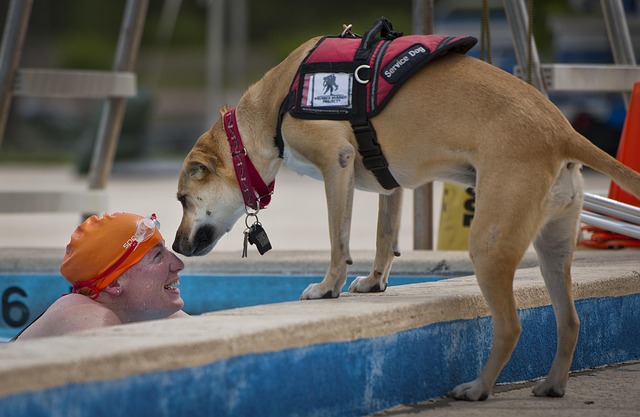
Service dogs are becoming a more common sight, which is great news for both dogs and the people who need them! More people with disabilites are finding friends to help make everyday tasks easier. And many dogs thrive when given a job to do. It’s a win-win!
Do you know what to do when you see a service dog? Most of us know not to pet a service dog no matter how irrisistible he may be, but there’s other things you can do to help make his job easier.
1. Don’t Pet A Service Dog
A service dog is a working dog – although it can be difficult to resist, you should not pet a service dog. Service dogs are very well trained and will not bite. But he needs to stay alert while on duty, and petting him can be a distraction. You may ask to pet a service dog, but it’s likely that the answer will be no. Don’t worry – he gets lots of love from his thankful handler when he’s off-duty.
2. Don’t Ignore The Handler
Ignoring a person to talk only to their dog is just plain rude. Speaking to a service dog is another distraction from his work. It’s also important not to ignore the handler when he asks you to step away, or gives a similar request. They know best how their service dog works, and asking you to cooperate may help make their dog’s job easier.
3. Keep Your Dog Away
Your dog will probably be eager to socialize with any dog he sees, but it’s best to keep your pup away from a working dog.
Though your dog may be well-behaved, there have been incidents with untrained or reactive dogs harming service animals. This can cause the service dog trauma that may make it difficult to perform his job for some time, which can make life hard for someone who relies on him.
4. Don’t Offer A Service Dog Food
It may seem like a good idea to offer a service dog a treat or food for a job well done, but offering any dog food without asking first isn’t very good etiquette. Furthermore, for a service dog, food is just another distraction from his work.
5. Give The Right-Of-Way
Giving a service dog and his handler the right-of-way in walkways and on sidewalks will help make navigating busy areas easier. Furthermore, you shouldn’t walk with a dog and his handler without permission. It can be confusing for the dog and might cause a misstep or an accident.
6. Don’t Ask Why Someone Needs A Service Dog
It may seem like common sense, but asking someone you don’t know about why they need a service dog is not cool. Their reason is their business, and if they’d like you to know, they’ll inform you without you asking.
7. Follow Any Unattended Service Dog
A Tumblr post recently went viral after a woman with a service dog noticed that many people did not know what to do when her dog approached them alone. Her dog is trained to find help for her when she has a seizure, but many people just ignored him – some tried to shoo him away! She had only tripped that day and was fine – but it was clear that people needed to know why her dog was trying to get their attention. If you see a service dog without a handler, you should follow to see if their person needs help.
8. Be Familiar With The Law
We’re not suggesting that you memorize the Americans With Disabilies Act (ADA) word-for-word, but there’s a few points that it is helpful to be familiar with:
- Service dogs are allowed to go anywhere where the general public is allowed to be. This includes places pets are not allowed, like shops, restaurants, and government offices. Emotional support dogs are not, but may be allowed some places at the discretion of the business. (Learn more about the difference here.)
- Service dog handlers are not required to carry any certification, or produce any kind of proof that their dog is a service dog when taking him anywhere. Nor are they required to explain why they need a service dog. Staff may ask whether a dog is a service dog, and what task they are trained to perform.
- Allergies and fear of dogs are not excuses to deny entry or service to a service dog handler. But a dog who does not appear to be housebroken, or is not being properly controlled by the handler may be asked to be removed.
- Service dogs are not required to wear a vest, or even a tether or leash. Some dogs are capable of working off-leash just fine.
Be the first to comment